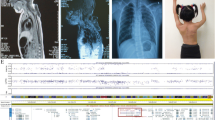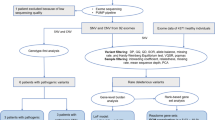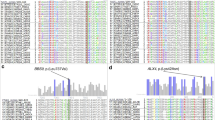Abstract
We previously reported a Vietnamese-American family with isolated autosomal dominant occipital cephalocele. Upon further neuroimaging studies, we have recharacterized this condition as autosomal dominant Dandy-Walker with occipital cephalocele (ADDWOC). A similar ADDWOC family from Brazil was also recently described. To determine the genetic etiology of ADDWOC, we performed genome-wide linkage analysis on members of the Vietnamese-American and Brazilian pedigrees. Linkage analysis of the Vietnamese-American family identified the ADDWOC causative locus on chromosome 2q36.1 with a multipoint parametric LOD score of 3.3, while haplotype analysis refined the locus to 1.1 Mb. Sequencing of the five known genes in this locus did not identify any protein-altering mutations. However, a terminal deletion of chromosome 2 in a patient with an isolated case of Dandy-Walker malformation also encompassed the 2q36.1 chromosomal region. The Brazilian pedigree did not show linkage to this 2q36.1 region. Taken together, these results demonstrate a locus for ADDWOC on 2q36.1 and also suggest locus heterogeneity for ADDWOC.






Similar content being viewed by others
References
Bassuk AG, McLone D, Bowman R, Kessler JA (2004) Autosomal dominant occipital cephalocele. Neurology 62:1888–1890
Beltran-Valero de Bernabe D, Currier S, Steinbrecher A, Celli J, van Beusekom E, van der Zwaag B, Kayserili H, Merlini L, Chitayat D, Dobyns WB, Cormand B, Lehesjoki AE, Cruces J, Voit T, Walsh CA, van Bokhoven H, Brunner HG (2002) Mutations in the O-mannosyltransferase gene POMT1 give rise to the severe neuronal migration disorder Walker-Warburg syndrome. Am J Hum Genet 71:1033–1043
Bien-Willner GA, Stankiewicz P, Lupski JR (2007) SOX9cre1, a cis-acting regulatory element located 1.1 Mb upstream of SOX9, mediates its enhancement through the SHH pathway. Hum Mol Genet 16:1143–1156
Carvalho DR, Giuliani LR, Simao GN, Santos AC, Pina-Neto JM (2006) Autosomal dominant atretic cephalocele with phenotype variability: report of a Brazilian family with six affected in four generations. Am J Med Genet A 140:1458–1462
Descipio C, Schneider L, Young TL, Wasserman N, Yaeger D, Lu F, Wheeler PG, Williams MS, Bason L, Jukofsky L, Menon A, Geschwindt R, Chudley AE, Saraiva J, Schinzel AA, Guichet A, Dobyns WE, Toutain A, Spinner NB, Krantz ID (2005) Subtelomeric deletions of chromosome 6p: molecular and cytogenetic characterization of three new cases with phenotypic overlap with Ritscher-Schinzel (3C) syndrome. Am J Med Genet A 134:3–11
Dixon-Salazar T, Silhavy JL, Marsh SE, Louie CM, Scott LC, Gururaj A, Al-Gazali L, Al-Tawari AA, Kayserili H, Sztriha L, Gleeson JG (2004) Mutations in the AHI1 gene, encoding jouberin, cause Joubert syndrome with cortical polymicrogyria. Am J Hum Genet 75:979–987
Ferland RJ, Eyaid W, Collura RV, Tully LD, Hill RS, Al-Nouri D, Al-Rumayyan A, Topcu M, Gascon G, Bodell A, Shugart YY, Ruvolo M, Walsh CA (2004) Abnormal cerebellar development and axonal decussation due to mutations in AHI1 in Joubert syndrome. Nat Genet 36:1008–1013
Franz T, Kothary R (1993) Characterization of the neural crest defect in Splotch (Sp1H) mutant mice using a lacZ transgene. Brain Res Dev Brain Res 72:99–105
Grinberg I, Northrup H, Ardinger H, Prasad C, Dobyns WB, Millen KJ (2004) Heterozygous deletion of the linked genes ZIC1 and ZIC4 is involved in Dandy-Walker malformation. Nat Genet 36:1053–1055
Gudbjartsson DF, Thorvaldsson T, Kong A, Gunnarsson G, Ingolfsdottir A (2005) Allegro version 2. Nat Genet 37:1015–1016
Gurnett CA, Bowcock AM, Dietz FR, Morcuende JA, Murray JC, Dobbs MB (2007) Two novel point mutations in the long-range SHH enhancer in three families with triphalangeal thumb and preaxial polydactyly. Am J Med Genet A 143:27–32
Hart MN, Malamud N, Ellis WG (1972) The Dandy-Walker syndrome. A clinicopathological study based on 28 cases. Neurology 22:771–780
Hoffmann K, Lindner TH (2005) easyLINKAGE-Plus-automated linkage analyses using large-scale SNP data. Bioinformatics 21:3565–3567
Hol FA, Hamel BC, Geurds MP, Mullaart RA, Barr FG, Macina RA, Mariman EC (1995) A frameshift mutation in the gene for PAX3 in a girl with spina bifida and mild signs of Waardenburg syndrome. J Med Genet 32:52–56
Iafrate AJ, Feuk L, Rivera MN, Listewnik ML, Donahoe PK, Qi Y, Scherer SW, Lee C (2004) Detection of large-scale variation in the human genome. Nat Genet 36:949–951
Jeong Y, El-Jaick K, Roessler E, Muenke M, Epstein DJ (2006) A functional screen for sonic hedgehog regulatory elements across a 1 Mb interval identifies long-range ventral forebrain enhancers. Development 133:761–772
Keller C, Hansen MS, Coffin CM, Capecchi MR (2004) Pax3:Fkhr interferes with embryonic Pax3 and Pax7 function: implications for alveolar rhabdomyosarcoma cell of origin. Genes Dev 18:2608–2613
Kujat A, Veith VP, Faber R, Froster UG (2007) Prenatal diagnosis and genetic counseling in a case of spina bifida in a family with Waardenburg syndrome type I. Fetal Diagn Ther 22:155–158
Kyttala M, Tallila J, Salonen R, Kopra O, Kohlschmidt N, Paavola-Sakki P, Peltonen L, Kestila M (2006) MKS1, encoding a component of the flagellar apparatus basal body proteome, is mutated in Meckel syndrome. Nat Genet 38:155–157
Lu W, Zhu H, Wen S, Laurent C, Shaw GM, Lammer EJ, Finnell RH (2007) Screening for novel PAX3 polymorphisms and risks of spina bifida. Birth Defects Res A Clin Mol Teratol 79:45–49
Mansouri A, Stoykova A, Gruss P (1994) Pax genes in development. J Cell Sci Suppl 18:35–42
Mansouri A, Hallonet M, Gruss P (1996) Pax genes and their roles in cell differentiation and development. Curr Opin Cell Biol 8:851–857
Martinez-Lage JF, Martinez Robledo A, Poza M, Sola J (1996) Familial occurrence of atretic cephaloceles. Pediatr Neurosurg 25:260–264
Mavrogiannis LA, Antonopoulou I, Baxova A, Kutilek S, Kim CA, Sugayama SM, Salamanca A, Wall SA, Morriss-Kay GM, Wilkie AO (2001) Haploinsufficiency of the human homeobox gene ALX4 causes skull ossification defects. Nat Genet 27:17–18
Moase CE, Trasler DG (1989) Spinal ganglia reduction in the splotch-delayed mouse neural tube defect mutant. Teratology 40:67–75
Murray JC, Johnson JA, Bird TD (1985) Dandy-Walker malformation: etiologic heterogeneity and empiric recurrence risks. Clin Genet 28:272–283
Nye JS, Balkin N, Lucas H, Knepper PA, McLone DG, Charrow J (1998) Myelomeningocele and Waardenburg syndrome (type 3) in patients with interstitial deletions of 2q35 and the PAX3 gene: possible digenic inheritance of a neural tube defect. Am J Med Genet 75:401–408
O’Connell JR, Weeks DE (1998) PedCheck: a program for identification of genotype incompatibilities in linkage analysis. Am J Hum Genet 63:259–266
Parisi MA, Bennett CL, Eckert ML, Dobyns WB, Gleeson JG, Shaw DW, McDonald R, Eddy A, Chance PF, Glass IA (2004) The NPHP1 gene deletion associated with juvenile nephronophthisis is present in a subset of individuals with Joubert syndrome. Am J Hum Genet 75:82–91
Reddy AT, Hedlund GL, Percy AK (2000) Enlarged parietal foramina: association with cerebral venous and cortical anomalies. Neurology 54:1175–1178
Robert A (1954) Analysis of the developmental effects of a lethal mutation in the house mouse. J Exp Zool 127:305–329
Sertie AL, Sossi V, Camargo AA, Zatz M, Brahe C, Passos-Bueno MR (2000) Collagen XVIII, containing an endogenous inhibitor of angiogenesis and tumor growth, plays a critical role in the maintenance of retinal structure and in neural tube closure (Knobloch syndrome). Hum Mol Genet 9:2051–2058
Shim SH, Wyandt HE, McDonald-McGinn DM, Zackai EZ, Milunsky A (2004) Molecular cytogenetic characterization of multiple intrachromosomal rearrangements of chromosome 2q in a patient with Waardenburg’s syndrome and other congenital defects. Clin Genet 66:46–52
Smith UM, Consugar M, Tee LJ, McKee BM, Maina EN, Whelan S, Morgan NV, Goranson E, Gissen P, Lilliquist S, Aligianis IA, Ward CJ, Pasha S, Punyashthiti R, Malik Sharif S, Batman PA, Bennett CP, Woods CG, McKeown C, Bucourt M, Miller CA, Cox P, Algazali L, Trembath RC, Torres VE, Attie-Bitach T, Kelly DA, Maher ER, Gattone VH II, Harris PC, Johnson CA (2006) The transmembrane protein meckelin (MKS3) is mutated in Meckel-Gruber syndrome and the wpk rat. Nat Genet 38:191–196
Tal Y, Freigang B, Dunn HG, Durity FA, Moyes PD (1980) Dandy-Walker syndrome: analysis of 21 cases. Dev Med Child Neurol 22:189–201
Tassabehji M, Read AP, Newton VE, Patton M, Gruss P, Harris R, Strachan T (1993) Mutations in the PAX3 gene causing Waardenburg syndrome type 1 and type 2. Nat Genet 3:26–30
Terwilliger JD, Ott J (1994) Handbook of human genetic linkage. Johns Hopkins University Press, Baltimore
Terzic J, Saraga-Babic M (1999) Expression pattern of PAX3 and PAX6 genes during human embryogenesis. Int J Dev Biol 43:501–508
Thiele H, Nurnberg P (2005) HaploPainter: a tool for drawing pedigrees with complex haplotypes. Bioinformatics 21:1730–1732
Valente EM, Silhavy JL, Brancati F, Barrano G, Krishnaswami SR, Castori M, Lancaster MA, Boltshauser E, Boccone L, Al-Gazali L, Fazzi E, Signorini S, Louie CM, Bellacchio E, Bertini E, Dallapiccola B, Gleeson JG (2006) Mutations in CEP290, which encodes a centrosomal protein, cause pleiotropic forms of Joubert syndrome. Nat Genet 38:623–625
Valente KD, Valente M (2004) Epilepsy in one family with parietal foramina: an incidental finding? J Neurol Neurosurg Psychiatry 75:1648–1649
van Reeuwijk J, Janssen M, van den Elzen C, Beltran-Valero de Bernabe D, Sabatelli P, Merlini L, Boon M, Scheffer H, Brockington M, Muntoni F, Huynen MA, Verrips A, Walsh CA, Barth PG, Brunner HG, van Bokhoven H (2005) POMT2 mutations cause alpha-dystroglycan hypoglycosylation and Walker-Warburg syndrome. J Med Genet 42:907–912
Vega H, Waisfisz Q, Gordillo M, Sakai N, Yanagihara I, Yamada M, van Gosliga D, Kayserili H, Xu C, Ozono K, Jabs EW, Inui K, Joenje H (2005) Roberts syndrome is caused by mutations in ESCO2, a human homolog of yeast ECO1 that is essential for the establishment of sister chromatid cohesion. Nat Genet 37:468–470
Waters BL, Allen EF, Gibson PC, Johnston T (1993) Autopsy findings in a severely affected infant with a 2q terminal deletion. Am J Med Genet 47:1099–1103
Zhao X, Chi L, Zhao Y, Chi Z (2007) A five-generation family with occipital encephalocele. Clin Neurol Neurosurg 109:81–84
Acknowledgments
We would like to thank Hoang Le and Dung Tri Pham, HoChiMinh City Hospital, HoChiMinh City, Vietnam, for their assistance in patient recruitment. A.J. is supported by NIH pre-doctoral NRSA grant F30-NS51962. K.A.A. is supported by NIH Pre-doctoral grant GM007839–26. A.G.B. is supported by NIH grant K08-NS48174.
Author information
Authors and Affiliations
Corresponding author
Rights and permissions
About this article
Cite this article
Jalali, A., Aldinger, K.A., Chary, A. et al. Linkage to chromosome 2q36.1 in autosomal dominant Dandy-Walker malformation with occipital cephalocele and evidence for genetic heterogeneity. Hum Genet 123, 237–245 (2008). https://doi.org/10.1007/s00439-008-0467-y
Received:
Accepted:
Published:
Issue Date:
DOI: https://doi.org/10.1007/s00439-008-0467-y




